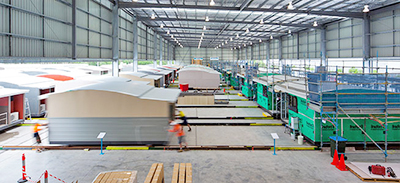Seven major trends in Australia's construction industry
EXTRA >>
CONSTRUCTION Skills Queensland (CSQ) has identified seven major trends in the construction industry that are having an impact right now in the state – and elsewhere in Australia.
From this research, to help construction companies plan ahead, Construction Skills Queensland’s Evidence and Data Team put together a list of hot trends likely to shape the industry in 2016. 
Return of new builds – Traditionally new builds account for about nine out of 10 building projects in Queensland, with the balance coming in the form of additions, alterations and conversions. In the years following the Global Financial Crisis (GFC), many people opted to renovate instead of build new, so the proportion of new builds dropped to as low as 80 percent. Data indicates the historical pattern is being restored, and CSQ predicts the share of new builds will stabilise around the 90 percent norm in 2016.
Healthy residential sector – Residential building has been picking up the slack left by the steep wind-down in mining construction in recent years. Both 2014 and 2015 saw double-digit growth in building starts in Queensland. While this trend will soften in 2016, CSQ expects solid single-digit growth for Queensland building starts, probably around 5 percent.
Labour surplus to peak – The decline in total construction activity across Queensland in recent years led to a surplus of construction workers. There are simply fewer projects than people ready to work. CSQ predicted this surplus would peak in 2016, and begin its return toward balance. It is estimated the number of unemployed construction workers in Queensland will average around 16,000 in 2016, about 8 percent of the construction workforce.
Prefabrication and modular homes – An increasing amount of both residential and commercial construction work will be completed in controlled building environments. Prefabrication has the potential to offer time and cost savings over conventional construction methods. CSQ is already starting to see whole townhouse communities built using modular components.
Timber resurgence – Cross laminated timber (CLT) or ‘tilt up timber’ is popular in Europe and North America. On the back of some recent successful trials here in Australia, CSQ expects this technology to be adopted more widely by the industry. Strong and lightweight, CLT offers a stylish alternative to concrete and can be used to form complete floors, roofs and walls. As a timber product, CLT is also often a more sustainable choice.
Smart homes – Home automation platforms are making it easier than ever for homeowners to centrally control entertainment, air-conditoning, lighting, appliances, alarm systems and locks from their tablets. These systems are becoming more common in new homes and often require complex electrical work to install.
Opportunities in installation services – The Australian Government Department of Employment expects building installation services to become a substantial source of jobs growth over the next five years. The number of workers in the category, which comprises awnings, curtains, elevators, escalators, flywire screens and insulation, is set to jump by 20.7 percent over the next five years.
ends

 How to resolve AdBlock issue?
How to resolve AdBlock issue?